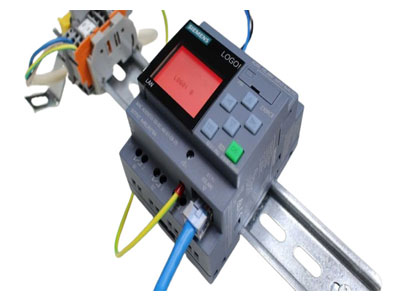How PLC Works?
Key Takeaway
A PLC, or Programmable Logic Controller, works in simple steps. First, it reads the input signals from devices like sensors. Then, it processes these inputs based on a user-created program. This program contains instructions on what actions to take. After processing, the PLC updates the outputs, such as turning on a motor or light. This cycle repeats continuously. The PLC ensures that industrial processes are automated and efficient. By following this cycle, a PLC can control and monitor various tasks in a factory or industrial setting
Basic Architecture of PLCs
PLCs, or Programmable Logic Controllers, are specialized industrial computers designed to automate control processes in manufacturing plants, machinery, and other industrial settings. They consist of several key components, including a central processing unit (CPU), input/output modules (I/O), memory, and communication interfaces. The CPU serves as the brain of the PLC, executing control logic programmed by engineers. Input/output modules interface with external devices such as sensors and actuators, allowing the PLC to receive input signals and send output signals to control industrial processes. Memory stores the PLC program, data, and system configuration, while communication interfaces enable connectivity with other devices and systems in the industrial network.

The PLC Operation Cycle Explained
The operational cycle of a Programmable Logic Controller (PLC) is fundamental to its functionality in industrial automation. It initiates with the scanning phase where the PLC systematically gathers input data from connected devices like sensors and switches. Following this, the PLC proceeds to execute the control program stored within its memory. This program contains a set of predefined logic instructions that the PLC processes to determine the appropriate actions based on the input signals received.
Once the processing is complete, the PLC updates the output signals, which are then transmitted to control external devices such as motors, valves, and relays. These outputs dictate the actions these devices should take, effectively influencing the operation of the industrial process. After completing these tasks, the PLC enters a resting state, marking the end of one cycle.
This cyclic process ensures the continuous and real-time monitoring and control of industrial processes, contributing to the efficiency and reliability of automation systems. By understanding the PLC operation cycle, engineers can design and optimize control strategies to meet specific industrial requirements, ensuring smooth and uninterrupted operations.
You May Like to Read
Input/Output Processing in PLCs
Input/output (I/O) processing forms the backbone of PLC functionality, facilitating the interaction between the PLC and external devices crucial for industrial automation. Input modules serve as the gateway for the PLC to receive signals from various sensors, switches, and other input devices present in the system. These modules perform the vital task of converting physical phenomena, such as temperature, pressure, and position, into digital signals that the PLC can interpret and process.
Once the PLC receives input signals, it proceeds to execute control logic based on the information received. This logic, programmed into the PLC, dictates the appropriate actions to be taken in response to specific input conditions. Subsequently, the PLC generates output signals, which are transmitted to output modules.
Output modules, in turn, interface with actuators, relays, and other output devices to translate the digital signals from the PLC into physical actions. These actions could include motor rotation, valve actuation, or alarm activation, depending on the requirements of the industrial process. This bidirectional communication between the PLC and external devices enables precise control and monitoring, ensuring the smooth and efficient operation of industrial systems.
Real-World Examples of PLC Operations
PLCs serve as the backbone of industrial automation, with a myriad of applications across diverse sectors. One prime example is in automotive manufacturing, where PLCs orchestrate the seamless operation of robotic arms, conveyor belts, and welding machines on assembly lines. This precise coordination ensures efficient production while maintaining high-quality standards.
In the food processing industry, PLCs play a crucial role in regulating various parameters such as temperature, humidity, and mixing processes. By doing so, they uphold product quality and safety standards, ensuring that consumers receive goods that meet stringent quality requirements.
Furthermore, PLCs are indispensable in power generation facilities, where they control turbines, generators, and distribution systems. By managing these critical components, PLCs ensure a reliable and efficient supply of electricity to homes, businesses, and industries.
These real-world examples underscore the versatility and effectiveness of PLCs in automating industrial processes, highlighting their importance in driving efficiency, productivity, and safety across various sectors of the economy.
Troubleshooting Common PLC Operational Issues
Troubleshooting common operational issues with PLCs is a critical skill for engineers working in industrial settings. These issues can arise from various sources, including hardware malfunctions, programming errors, and environmental factors such as temperature and humidity fluctuations. Identifying the root cause of a problem often begins with observing symptoms and gathering relevant data, such as error messages and system logs.
Engineers rely on diagnostic tools like PLC programming software and hardware testers to pinpoint issues accurately. These tools allow them to analyze program logic, test input/output modules, and assess communication protocols for any faults. Additionally, regular maintenance practices, such as software updates and hardware inspections, are vital for preventing issues before they escalate.
By understanding common PLC operational issues and implementing effective troubleshooting strategies, engineers can minimize downtime and ensure the reliability of PLC-based control systems. This proactive approach not only saves time and resources but also contributes to the overall efficiency and productivity of industrial operations.
Conclusion
In conclusion, PLCs are essential components of modern industrial automation, offering precise control, flexibility, and reliability in controlling industrial processes. Understanding the basic architecture, operation cycle, input/output processing, real-world applications, and troubleshooting techniques of PLCs is crucial for engineers involved in designing, implementing, and maintaining industrial control systems. By leveraging PLC technology effectively, engineers can enhance system efficiency, optimize production processes, and ensure the smooth operation of industrial facilities. Continual learning and adaptation to evolving technologies are essential for engineers to stay abreast of advancements in PLC technology and maximize its benefits in industrial applications.
